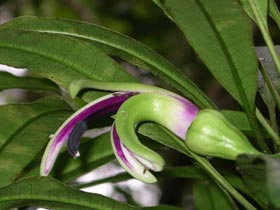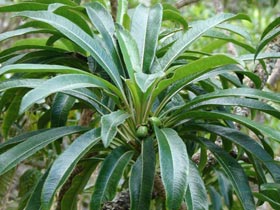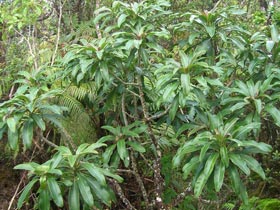Clermontia arborescens subsp. waihiae
Genus
Clermontia
Species
arborescens
Subspecies
- waihiae
Hawaiian Names with Diacritics
- Hāhā
- ʻŌhā
- ʻŌhā wai
- ʻŌhā wai nui
Hawaiian Names
- Haha
- Oha
- Oha wai
- Oha wai nui
Synonyms
- Delissea waihiae
Distribution Status
Endemic
Endangered Species Status
At Risk
Plant Form / Growth Habit
- Shrub
- Tree
Mature Size, Height (in feet)
- Shrub, Small, 2 to 6
- Shrub, Medium, 6 to 10
- Shrub, Tall, Greater than 10
- Tree, Small, 15 to 30
Mature Size, Width
ʻŌha wai nui has a 6 foot spread. [Ethan Romanchak, Native Nursery, LLC]
Life Span
Long lived (Greater than 5 years)
Landscape Uses
- Specimen Plant
Additional Landscape Use Information
ʻŌhā wai nui has a beautiful Clermontia form and should be grown like other medium wet species. [Ethan Romanchak, Native Nursery, LLC]
Source of Fragrance
- No Fragrance
Plant Produces Flowers
Yes
Flower Type
Showy
Flower Colors
- Greenish-White
- Pink
- Yellow
Additional Flower Color Information
Depending on the subspecies, the showy flowers are greenish or greenish-white flowers with greenish-white or magenta interior. [3]
Blooming Period
- Summer
Additional Blooming Period and Fruiting Information
The flowers are large and fleshy Lobelioid-type flowers and bloom in late summer. They produce large orange fruits. [Ethan Romanchak, Native Nursery, LLC]
Plant texture
- Coarse
Additional Plant Texture Information
ʻŌhā wai nui has glossy oblong leaves.
Leaf Colors
- Dark Green
Additional Pest & Disease Information
Root rot. [Ethan Romanchak, Native Nursery, LLC]
Fertilizer
Responds well to low fertilizer applied often. [Ethan Romanchak, Native Nursery, LLC]
Pruning Information
Do not prune. [Ethan Romanchak, Native Nursery, LLC]
Water Requirements
- Wet
Additional Water Information
High amounts of water with good drainage. [Ethan Romanchak, Native Nursery, LLC]
Soil must be well drained
Yes
Light Conditions
- Full sun
- Partial sun
Soils
- Organic
Limitations
Susceptible to root rot, but good drainage helps. Does not tolerate waterlogging. [Ethan Romanchak, Native Nursery, LLC]
Natural Range
- Molokaʻi
- Lānaʻi
- Maui
Natural Zones (Elevation in feet, Rainfall in inches)
- 1000 to 1999, 50 to 100 (Mesic)
- 1000 to 1999, Greater than 100 (Wet)
- 2000 to 2999, 50 to 100 (Mesic)
- 2000 to 2999, Greater than 100 (Wet)
- 3000 to 3999, 50 to 100 (Mesic)
- 3000 to 3999, Greater than 100 (Wet)
- 4000 to 4999, 50 to 100 (Mesic)
- 4000 to 4999, Greater than 100 (Wet)
Habitat
- Epiphyte
- Terrestrial
Additional Habitat Information
ʻŌhā wai nui inhabit mesic to montane rain forests and cloud forests. The subspecies arborescens (ʻĪao Valley to Hanaʻula, West Maui) is considered rare, while subsp. waihiae (northern West Maui, East Maui) and subsp. waikoluensis (east Molokaʻi, Lānaʻi) are apparently secure in numbers. [1]
![]() Special Features and Information
Special Features and Information
General Information
The twenty-four Clermontia species (ʻōhā wai) are among the more common of the lobelioides (Campanulaceae), but also include some rare and endangered species.
Etymology
The generic name Clermontia is named on behalf M. le Marquis de Clermont-Tonnerre, Minister of the French Navy at the time of the Freycinet expedition (1817-1820).
The Latin specific name arborescens, tree-like, is in reference to its habit.
Background Information
Clermontia are "candelabra-like" branching, woody shrubs or small trees. While nearly all the species are found as terrestrials, over half of the species also grow as epiphytes, that is they grow on other plants, with one species always found as such. As epiphytes, they are often found on mossy-trunks or branches of larger trees such as koa, ʻōhiʻa, and ʻōlapa (Cheirodendron trigynum). [1] These plants produce two or more flowers on a typical inflorescence and pollinated by honeycreepers (e.g. ʻiʻiwi, ʻakialoa) seeking nectar. [2] Yellow or orange berries are produced after flowering.
The distinguishing characteristics of the three subspecies belonging to Clermontia arborescens is found in the shape of the calyces, or sepals, the part of the flower just below the petals (corolla). The Hawaiian name for this species (C. arborescens), ʻŌhā wai nui, means "big ʻōhā wai" in reference to the large flowers.
Early Hawaiian Use
Bird Catching:
The latex was also used in pīlali, or bird lime, to snare small forest birds for feathers for cloaks, capes, helmets, lei, and kāhili. The flowers of ʻōhā wai were used to lure the victims in kia manu (bird-catching by gumming). [1] How ironic that the very plants that the honeycreepers seek as a food source would also be used to lure them to be ensnared.
Food:
Early Hawaiians used ʻōhā wai (Clermontia spp.) as a minor food source. The leaves were boiled before eating and the berries were eaten fresh and said to have a sweet taste. However, the berries of ʻōhā wai nui (C. arborescens) are said to be "not so tasty." [6]
Medicinal:
The latex of half-ripe berries of ʻōhā wai nui (C. arborescens) were mixed with sweet potato (ʻuala) and used to restore or increase breast milk production [4,5].
The latex was also used to treat asthmatics or to treat deep puncture wounds when mixed with ʻakoko (Chamaesyce celastroides var. lorifolia). The flowers were fed to children suffering from pāʻaoʻao (childhood disease, with physical weaknesses). The flowers and fruits were given to babies to cure lepo paʻa (constipation). [6]
Modern Use
With their general ease of cultivation, several species of Clermontia are slowly being incorporated into residential landscaping.
Additional References
[1] "Systematic Botany Monographs, Volume 32, Systematics of Clermontia (Campanulaceae-Lobelioideae)" by Thomas Lammers, pages 5, 6, 10-11, 24-30.
[2] "The Hawaiian Honeycreeper (Drapanididae)" by H. Douglas Pratt, pages 18, 144.
[3] "Plants in Hawaiian Culture" by Beatrice H. Krauss, page 256.
[4] "Hawaiian Herbs of Medicinal Value" by D. M. Kaaiakamanu, J. K. Akina, page 30.
[5] "Native American Ethnobotany" by Daniel E. Moerman, page 170.
[6] "Native Hawaiian Medicine--Volume III" by The Rev. Kaluna M. Kaʻaiakamanu, page 78.
Plant Gallery
Back to Plant List
Other Nursery Profiles for Clermontia arborescens subsp. waihiae



